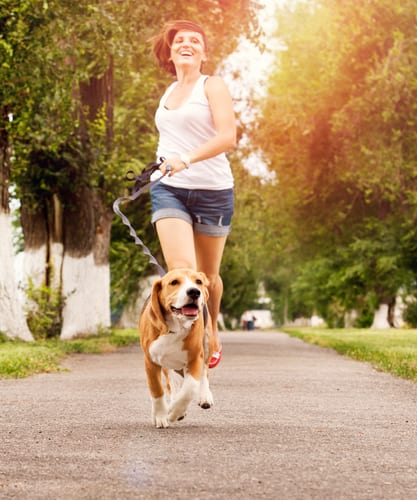People are generally always concerned with their weight – and it’s no wonder given our current society. While being supermodel thin may not be everyone’s ideal goal (and with reason!) it is important not to underestimate the dangers of obesity. There is a healthy weight for everyone, and maintaining that promotes a healthier life in every aspect.
With obesity rates at an all-time high, it’s no wonder that an estimated 55.6% of dogs are overweight or obese as well.

Unfortunately, the dangers of obesity are not limited to humans – our dogs suffer just as much. Not only can pets fail ill to Type 2 Diabetes, but they will also have excess strain on their bones and organs, increased risk for heart and respiratory disease, multiple cancers, and an overall decreased life expectancy. Just like humans, putting on the pounds is often far easier than taking them off. Below are some tips on how to maintain your pet’s weight loss!
Knowing Ideal Weight
This is SO important for pet owners. It might be hard to believe, but the average pet owner really has no idea what the ideal weight for their dog is! In fact, when I’m out with my working dogs, I often get told they’re too skinny! Ideal weight in dogs is not a number, but a certain ratio. You want ribs to be easily felt, but not necessarily seen, and a defined waist. You can use the chart below to get a better idea of what your dog should look like:

Exercise
You were probably hoping this wasn’t on the list. But it is! Not only is exercise essential for your dog’s mental health, it’s needed to maintain his physical health as well! But exercise needs to be more than just a short walk around the block, depending on your dog. A leisurely stroll is nice, but if you’re looking to lose weight and maintain that weight loss you need to get power walking (or running if you can!) to make sure those calories are getting used.
This is beneficial for you and your dog! Try and set a pace of about 15 minutes per mile, and avoid stopping for all of the sniffing and marking that may typically slow down your walk. Remember that even 20 minutes a day at a decent speed can improve your health, so put those shoes on and take your dog out!
Diet Changes
You may not necessarily need to change your pets’ food. In fact, we generally advise against it unless you’re experiencing other issues. It’s usually the amount of food that’s the problem. Try to avoid table scraps, and make sure you account for treats when deciding how much to feed your dog during his meals. The guidelines on the pet food bags are just that, guidelines, so experiment with your dog and see what works best for him.
Each dog has different body types and activity levels, all of which need to be considered when setting the pace on diet. It’s best to feed scheduled meals rather than free feeding, as you have full control over the amount of food your dog eats. If your pet is acting too hungry when you know he’s getting enough to eat, try adding in some fresh, steamed green beans. These are an excellent source of fiber with almost zero calories – so your dog will feel full without adding on any weight!
Related: Best Diet Dog Foods for Weight Loss
Talk to Your Vet
Weight loss is important, and your veterinarian is one of the best places to start. If your dog is severely obese, your vet can help you get started without causing too much discomfort for your dog. Remember that an overweight dog is more prone to injuries, so you’ll have to ease into exercise. Your veterinarian can also help you rule out ailments that can cause obesity, such as hypothyroidism. Even if you don’t think there’s anything medically wrong, it’s advised to always to consult your veterinarian if you’re making any drastic changes for your pet.
Monitor Weight
This is something you would do as well! Keeping your pet’s weight in check is easier when you check it regularly. Your dog should typically lose about 1lb per month, and monthly weigh-ins will help you determine whether or not your pup’s weight loss program is working for him. Working with your veterinarian in determining this plan and making sure it’s working (and not too well, too much weight loss at once can be dangerous) will guide you and your pet back on track to a healthy weight.
Most things are easier said than done, but this doesn’t always have to be the case. Remember that you are your dog’s willpower and are in control of his health. Allowing him to become obese is detrimental, and we know that you don’t want your pet leaving your side any sooner than he needs to. Maintaining a healthy weight is essential to maintaining a long, healthy life. With time and effort on your pet, your pup will be healthier and happier than ever.
 Toledo, United States.
Toledo, United States.
